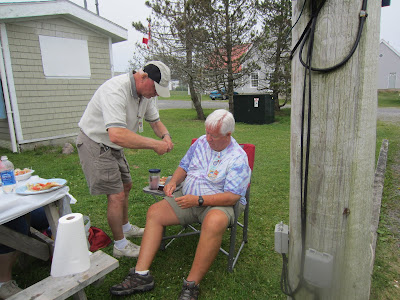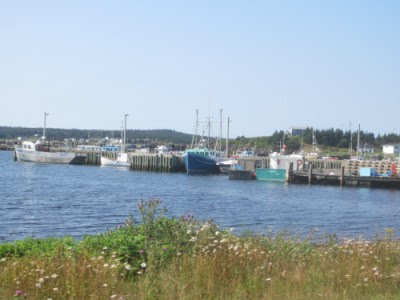Amoeba Sailing Tours - Baddeck, Nova Scotia
Amoeba Sailing Tours is a small family business operating from the village of Baddeck, on Cape Breton Island. Captain John Bryson, Owner/ Operator of the Amoeba Sailing Tours offers passengers a unique opportunity to sail the Bras d’Or Lakes near Baddeck from the deck of a 67ft Schooner. The Amoeba has five sails, and is Staysail Schooner with a Wishbone Rig. She has a main sail. 2 staysails, a jib and a Wishbone. During our narrated tour of the harbor, our guide explained the Lake and the estate of Alexander Graham Bell and his heirs.
Alexander Graham Bell Museum – Baddeck, Nova Scotia
Located in the Village of Baddeck, a 25 acre park overlooking the Bras d'Or Lakes, a saltwater inland sea. This complex, with its three exhibit halls, contains the largest collection of Bell's artifacts and inventions, including replicas of the first telephones and a full scale model of the HD-4 hydrofoil craft. Baddeck, Cape Breton Island, is where Alexander Graham Bell, mostly famed as the inventor of the telephone chose to build his Canadian residence. Bell's estate, Beinn Breagh (Gaelic for 'beautiful mountain') can be viewed from the rooftop gardens of the complex. He was an eminent scientist, inventor, engineer and innovator who is credited with inventing the first practical telephone. Bell's father, grandfather, and brother had all been associated with work on elocution and speech, and both his mother and wife were deaf, profoundly influencing Bell's life's work. His research on hearing and speech further led him to experiment with hearing devices which eventually culminated in Bell being awarded the first US patent for the telephone in 1876.
Cape Breton, Nova Scotia
The Cabot Trail loops around the Northern tip of Cape Breton, Nova Scotia, 185 miles long. The trail passes through many charming communities, each with some fantastic scenery. The Cape Breton Highlands National Park lies along the Cabot Trail. We took the time to go whale watching and visited several commercial fishermans coves along the way. It wasn't until 1936 that the Cape Breton Highlands National Park was created. It consists of 366 square miles and protects the highlands and coastal wilderness stretching across the northern tip of Cape Breton Island between the Gulf of St. Lawrence and the Atlantic Ocean.
Keltic Lodge Resort – Cape Breton – Nova Scotia
High on a cliff overlooking the Atlantic Ocean, Keltic Lodge commands a view like no other. A view of Cape Smokey rising out of the sea greets your arrival. We stopped for their breakfast buffet. Our group somewhat overwhelmed them when we arrived only about 30 minutes before they were to end the buffet. They rose to the challenge however and everyone had a great breakfast before beginning the major portion of our Cabot Trail drive.
Meat Cove – Cape Breton – Nova Scotia
One of the highlights of our drive was Meat Cove which is the most northern tip of Cape Breton island. It is surrounded by jagged cliffs and valleys of connected mountains . The village is known for the spectacular views it provides for visitors and also for The Meat Cove Campground and Ocean Side Chowder Hut. The Meat Cove Campground opened in 1986 and is hosted by the MacLellan family. The campground provides people with spacious room for their tents, thirty unserviced campsites, newly built camp cabins, running water, hot showers, beautiful hiking trails mainly all with ocean view.
Many other pictures that I don't have room for here.
We catch the ferry in the morning for out last stop on the caravan.
Prince Edward Island



















































































